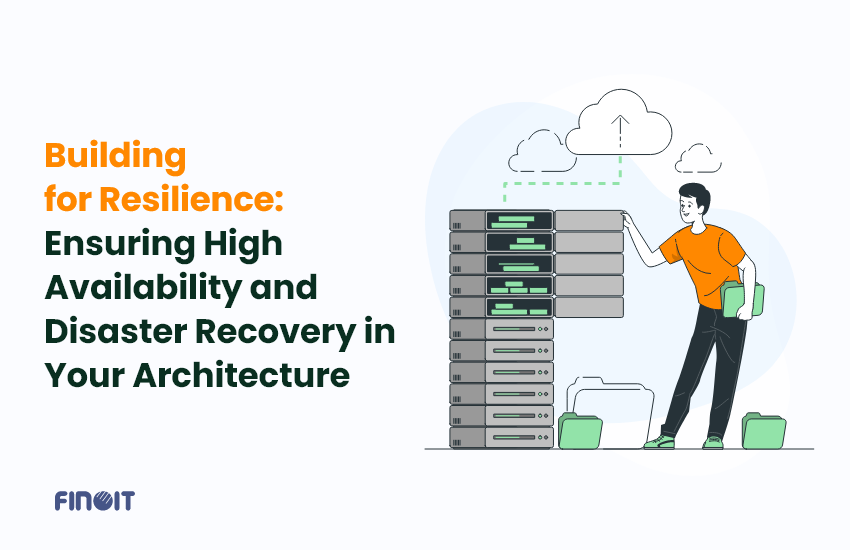Building for Resilience: Ensuring High Availability and Disaster Recovery in Your Architecture

Have you ever noticed how negligible the downtimes of large-scale applications like Netflix, Amazon, and Airbnb are? How do these applications stay online and available 24/7, even during unexpected failures or natural disasters? The answer lies in using high availability, fault tolerance, and disaster recovery strategies on their system architecture platform to provide continued service.
Technology downtime and business inoperability dissatisfy your customers and can directly impact your revenues. Hitachi Vantara, in one of its studies, ‘Embracing ITaaS for Adaptability and Growth’, reveals that 56% of businesses hamper their revenue due to service unavailability.
Even a minor gap in your services can create a domino effect on your business, affecting your customer experience (CX), your revenues, and your entire operation. Whether you are a startup founder or looking to improve the existing design of your architecture, building resilient systems with continuous availability, and effective disaster guarantees the reliability and performance of your products and services.
Designing a Resilient System
Without a resilient system, your business might have to bear the hefty cost of downtime. The latest reference can be the one-hour downtime of Amazon, which cost the company around $72 million and $99 million in sales. Similarly, Facebook lost a substantial $100 million because of an extended outage. You can save your business by following a system architecture with High Availability (HA) and Disaster Recovery (DR) which will ensure your customers have continuous access to your services in spite of any technical failure.
However, HA and DR, being two individual concepts, have deployment strategies that are vastly different, hence the best practices to include them in your application services are also different. Your hired software architect can combine these ideas to design a system that ensures reliable system operation, with minimum downtime. In the following part of the article, we will discuss the High Availability (HA) and Disaster Recovery (DR) approaches and the best practices to deploy them in your system architecture.
A System Architecture with High Availability (HA)
Continuous availability, aka, High Availability, refers to the uninterrupted accessibility and functionality of your systems and services, regardless of potential failures or maintenance activities. It’s a crucial aspect of a modern software architecture that ensures access to your applications or resources without disruption. With this approach in place, your business can uphold customer satisfaction, trust, and business continuity.
Furthermore, many industries have regulations mandating a certain level of availability to protect consumer data and ensure service reliability. Failure to maintain these necessary availability levels may lead to legal repercussions or penalties. To calculate the percentage of time your system was operable, you can use this formula:
x = (n – y) * 100/n
Here, ‘n’ depicts the total number of minutes within a span of 30 days, and y is synonymous with the total number of minutes your service has been unavailable in the same month.
Although there is no hard and fixed rule to make your system architecture highly available, there are some best practices that you can adopt to ensure you provide uninterrupted services to your customers:
Data Backups, Recovery, and Replication
If you want an exemplary process where your services are protected against system failure, it’s essential to have a solid backup and recovery strategy in place. You can store valuable data with proper backups to replicate or recreate them if necessary. Plan for data loss or corruption in advance, as these errors could create issues with customer authentication, damage financial accounts, and harm your business’s credibility within your industry ecosphere.
Furthermore, to keep up the data integrity, it’s recommended to create a full backup of the primary database and then incrementally test the source server for data corruption. This tactic will become your most crucial ally in the face of a catastrophic system failure.
Clustering
Application services are bound to fail at some point, even with the best technology integration. High availability ensures that your application services are delivered regardless of failures. Clustering can provide instant failover application services in the event of a fault. If your system architecture becomes ‘cluster-aware,’ calling resources from multiple servers becomes easier. Additionally, your primary server can fall back to a secondary server if it goes offline.
Furthermore, a HA cluster includes multiple nodes that provide information via shared data memory grids. This means that any node can be disconnected or shut down from the network, and the rest of the cluster will continue to operate normally as long as at least a single node is fully functional.
This approach allows each node to be upgraded individually and rejoined while the cluster operates. The high cost of purchasing additional hardware to implement a cluster can be mitigated by setting up a virtualized cluster that utilizes the available hardware resources.
Network Load Balancing
If you want to ensure that your application system remains available without interruption, load balancing can help. With this approach in place, traffic is automatically redirected to other servers still working, when one server fails. This not only ensures high availability but also makes it easier to add more servers if needed.
You can conduct load balancing in two ways:
- By pulling data from the servers
- By pushing data to the servers
Thus, load balancing helps your applications stay up and running even when something goes wrong.
FailOver Solutions
High availability architecture typically includes a group of servers that work together, with backup capabilities, that start functioning, if your primary server goes down. This backup mode, called ‘failover’, ensures that your application continues to function smoothly, for both planned and unplanned shutdowns.
Failover solutions can be either “cold,” meaning the secondary server is only started after the primary server is shut down, or “hot,” where all servers run simultaneously, and the load is directed to a single server at any given time. Regardless of the type of failover you adopt, the process is automatic and seamless for end users. In a highly controlled environment, failover can be managed through a Domain Name System (DNS).
Plan in advance to combat failure
To prepare for system failures and minimize downtime, you can take various actions like keeping records of failure or resource consumption to identify problems and analyze trends. This data can be collected by continuously monitoring operational workload.
Creating a recovery help desk can also be beneficial in gathering problem information, establishing a history of problems, and promptly resolving them. You should also have a well-documented recovery plan that is regularly tested to ensure it is practical in dealing with unplanned interruptions, which is well-communicated to your employees as well. Additionally, your employees should be adequately trained in availability engineering techniques to enhance their ability to design, deploy, and maintain HA architectures.
A System Architecture with Disaster Recovery (DA)
Disaster recovery is a crucial plan that businesses implement to ensure that their systems and applications can be restored after a catastrophic event, such as a natural disaster or cyberattack. It’s like a safety net for your business operations. Disaster recovery plans typically involve regularly backing up data and applications, securely storing them, and developing procedures for restoring them to their original state. Testing the recovery plan is also essential to ensure that it works effectively when needed.
While HA was about designing systems that can continue to operate through uncertainty, on the other hand, disaster recovery is about planning for and dealing with a disaster when it knocks out your application system. It covers pre-planning and post-disaster actions, including identifying critical business functions, prioritizing recovery efforts, and establishing communication channels.
Recovering from a major disaster can be a daunting task for any business. During such times, bad decisions are often made out of shock or fear of how to recover. Therefore, having a well-thought-out disaster recovery plan in place can help businesses minimize the impact of a disaster and recover more quickly. These are the ideal components that form it.
Risk Assessment and Business Impact Analysis:
It is crucial to assess and analyze potential hazards that could pose a threat to your organization, including but not limited to natural calamities, cyber assaults, hardware malfunctions, power disruptions, and other similar risks. It is essential to comprehend the potential impact of these risks on your systems, operations, and overall business functions to ensure that you are well-prepared to mitigate any adverse effects.
Define Recovery Objectives:
When it comes to disaster recovery planning, two important metrics are highly considerable:
- Recovery Time Objective (RTO)
- Recovery Point Objective (RPO)
The RTO helps determine the maximum amount of downtime that can be tolerated for critical systems. This metric answers how quickly your application must be restored after an incident. On the other hand, the RPO establishes the acceptable threshold for data loss. This metric determines how much data can be lost without significant consequences. Organizations can better prepare for and respond to potential disasters by understanding these two metrics.
Backup and Replication Strategy:
It is crucial to schedule frequent backups of vital data and systems to minimize the risk of data loss in a disaster. To ensure the availability and integrity of data, it is necessary to do data replication in separate physical or cloud locations. You can also create regular backups of critical data and applications and implement disaster recovery strategies that enable the quick restoration of those backups in case of a disaster. Doing so can mitigate the impact of a disaster and ensure that your business operations continue without any significant interruption.
Geographic Redundancy
To safeguard against service failures during catastrophic events like natural disasters, it is imperative to have a robust disaster recovery plan in place. Geo-redundancy is a key component of such a plan. It involves deploying multiple servers across different locations worldwide instead of relying on a single location. Each location should have its own independent application stack, including servers, storage, and networking infrastructure, to ensure maximum redundancy.
In the event of a disaster, traffic can be automatically redirected to another location, which ensures that customers can continue to use the service without any interruption. It is important to ensure that these locations are completely isolated from each other to avoid any single point of failure. This means that the servers in each location should be completely independent and not share any common infrastructure.
However, it is important to regularly test the geo-redundancy plan to ensure it works as expected. Regular testing helps to identify any weaknesses in the plan and allows for adjustments to be made to address them.
Redundancy and Failover:
When designing an architecture, it is important to consider redundancy as a key factor in ensuring continuous operation, even in a failure. This can be achieved by implementing multiple servers or components that take up the load when the primary system fails.
Automated failover systems can also be put in place to ensure a seamless switch to backup systems when primary systems fail. Additionally, it is crucial to replicate critical data and applications to secondary locations and set up failover mechanisms that can quickly switch traffic to the secondary location in the event of a disaster.
Cloud-Based Solutions:
By utilizing cloud services for backup, replication, and recovery solutions, organizations can ensure that their critical data and applications remain available during a disaster. Cloud providers offer robust disaster recovery services that can be customized to meet specific business needs.
The scalability of cloud environments allows you to adapt your resources as needed during recovery phases. Deploying critical applications and services across multiple regions ensures systems remain available even if one region experiences a disaster.
Disaster Recovery Plan (DRP):
Create a comprehensive manual that provides a thorough and detailed explanation of the recovery process. The manual should include a step-by-step guide that outlines the procedures to be followed during a recovery scenario.
It is essential to clearly define the roles and responsibilities of each team member involved in the recovery process to ensure optimal clarity and efficiency. Additionally, implementing security policies can prevent system outages due to security breaches.
Testing and Training:
It is crucial to conduct regular tests and simulations of potential disaster recovery scenarios to ensure that the recovery plan is effective and reliable. It is equally important to ensure that your IT team is well-equipped and properly trained to execute the recovery plan when needed.
You can collaborate with software development agencies for startups if you lack resources for your application’s service DR. By doing so, you can minimize the impact of any unexpected disruptions and ensure that your business operations can resume as quickly and seamlessly as possible.
Documentation and Communication:
To ensure an effective response to emergencies, it is crucial to maintain detailed documentation outlining the architecture and recovery procedures. This documentation should be readily accessible and understandable for all relevant parties.
Additionally, it is important to establish clear communication channels and escalation paths to facilitate streamlined coordination during recovery efforts. This includes identifying key stakeholders and outlining their roles and responsibilities throughout the recovery process.
Conclusion
To keep your business running smoothly and ensure that your systems are always available and your data is protected, strategies such as high availability, and disaster recovery are commendable.
Cloud computing and platforms like AWS and Azure can make it easier to implement these strategies. You can achieve HA and DR by leveraging the cloud without investing in expensive hardware or infrastructure.
By collaborating with companies providing expert Business IT Solutions, you can optimize your IT system and customize your IT network to improve the existing system and be protected in unexpected failures.
These platforms also provide a range of tools and services that can help you tailor your strategies to your specific needs and potential risks, minimizing service downtimes and protecting your business from unexpected disruptions.
To know how Finoit can help you design a resilient system architecture, request a demo today!


